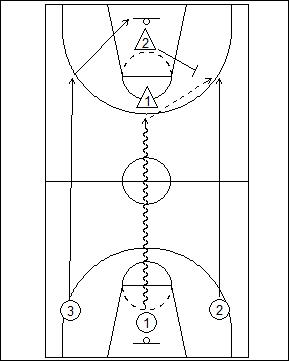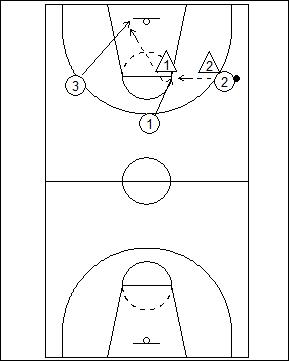3 vs. 2 Fast Break Offense Options
Being able to have your team execute in advantage situations is vital and the 3 vs. 2 Fast Break is one of these scenarios. If your team is fortunate enough to be presented with a situation that gives them a player advantage as a coach you want the only outcome to be a high percentage scoring option. Drilling your players to put themselves in the best possible scenario to achieve this is want the 3 vs. 2 fast break options discussed in this post is all about.
There are a many different options from a 3 vs. 2 fast break scenario. All of which ultimately depend as a coach on what you determine to be an acceptable level of risk when choosing shot selection for your team. The options discussed here for a 3 vs. 2 fast break situation are focused around high percentage shots in the keyway.
The 3 vs. 2 fast break options discussed here build upon the 2 vs. 1 fast break offense highlighted in the Duke 2 Man Transition Drill.
Points of Emphasis for these offensive options are:
The ball should be moved to the middle lane runner so the ball can be passed in either direction; the more confident your middle lane runner becomes while dribbling the ball the more detailed reads this player will be able to make. The side the ball should be passed to will be determined by the defence; if the basket player is overplaying one side then the pass should be made away from this side to increase the length of the defensive players close-out.
The wing player who received the ball should be looking to always initiate a strong driving lane to the basket; if there is a direct line to the basket with no defender in it then the lay-up is the primary scoring option. A further read for the wing player while in the driving lane is if the basket defender stays in between the edges of the backboard then the lay-up by this player remains the primary scoring option. This is because as a result of the defensive player’s lack of movement the offensive player will still be able to create a good angle with the use of the backboard to make the lay-up.
On the reversal back to the middle lane runner the set shot from this position becomes the secondary scoring option; providing following the pass to the wing the middle lane runner moves to the strong side elbow this will result in a high percentage open shot. Both defensive players will be in motion and both will be moving away from this position resulting in an increased amount of time for the shot to be taken.
The final option is for the reversal from the elbow to the weak side lane runner at the basket; the weak side lane runner once they see the ball is passed away from them should angle their run to the basket at the edge of the backboard. This will increase passing lanes and angle making an interception harder to effectively make by the defence.
Avoid having your players attempt to make the assist pass from the strong side to the weak side wing without first reversing the ball through the elbow position. This is because while this option can and will work it is a harder pass to make especially with so many bodies moving in quick succession in such a small area. This pass while highly efficient, will ultimately result in just as many turn-overs as shots.
These 3 vs. 2 fast break options can be integrated into many different drills. Examples would include:
- 3 vs. 2 Continuous
- 3 vs. 2 (shooter becomes defender) into 2 vs. 1
- 3 vs. 3 Line Touch (defender who is guarding the offensive player who received the pass must touch baseline before taking active part in defence)

Ball is dribbled down the middle lane.
Wide lane runners (Two and Three) sprint to foul line extended of either side of the floor.
The dribbler (One) draws defensive player.
When the pass is made to the wing player (Two) there are two options,
- If the defenders do not rotate player can drive to basket.
- If defenders rotate to ball pass is made back to middle lane runner after drawing the basket defender away from the split line.

Upon passing the ball to the wing initially, the middle lane runner will move to the strong-side elbow. One (1) should be ready set ready for the shot upon reversal.
If the middle lane runner (One) receives the ball back from the wing there are two options,
- If the defenders are slow to close-out a shot can be taken.
- If the defender closes-out hard a pass can be made to the weak-side lane runner (Three) for the lay-up.
It is important to highlight that depending on what your offensive transition tactics are that you can always implement breakdowns into your fast break options. These specific movements allow then for the fast break offense to flow seamlessly into your half-court offense without any significant secondary transition being needed.






Leave a Reply